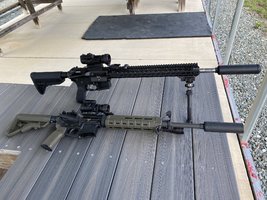The notion of over- or under-gassing is oversimplified and can miss some important elements of correctly gassing a DI rifle. There are 2 major considerations:
1. Time to unlocking
2. Duration of gas (aka dwell time) or rather time from projectile passing the gas port to exiting muzzle
Believe if or not, #1 is a major factor to how the rifle will run. A rifle length gas (12”) will provide later unlocking and thus smoother function due to lower pressures at the time of action unlocking. Since I run mostly suppressed (now that I’ve escaped MA) I have come to appreciate rifle length systems even more. They allow for a wider envelope of pressures, gas port sizes, -/+ suppressors etc and still function reliably.
An optimal setup is an 18 or 20” with rifle length gas. This provides the benefit of late unlocking AND still affords 6 or 8” of dwell distance, respectively. when dropping to a 16” barrel, a rifle length gas will have only 4” of dwell distance. That’s only 1/2 of a standard 20” barrel. Manufacturers may try to circumvent this problem by enlarging the gas port, but this only partly corrects the issue of potential undergassing. No matter how it’s sliced, the shortening of dwell time will create a narrower envelope of reliable function. Feed it weaker ammo or cold temperatures and what was reliable could choke.
With a 16” barrel, a mid-length gas will provide 9” of dwell distance, which again will have a wider range of reliable conditions, at the expense of earlier unlock time (compared to rifle length gas) and faster bolt cycling. with a suppressor it will beat itself hard unless one runs heavy A5 buffers, adjustable BCG or adjustable gas. For this reason more manufacturers are making mid-length gas barrels with smaller gas ports, such as Triarc, Rosco and BA.
in 308 the proposition gets even trickier because there’s zero standardization of gas port sizes with a cartridge that makes far more gas than a 223. My CMMG Mk3 has an 18” barrel with rifle length gas. It was severely over-gassed even with a rifle length gas system and required an adjustable gas block. I was annoyed. On the contrary I have a craptastic Midway USA AR Stoner LR-308 upper with exact same barrel length but it’s gassed much more appropriately and runs fine with a fixed gas block. This illustrates how two ”identical” barrels can have wildly different gas port sizes.
If I were building a 308 rifle, I’d start by measuring the gas port sizes and talk with barrel manufacturer to see what they recommend with respect to gas blocks, buffers types and weights (eg carbine, rifle, A5). For example, if that 16” rifle length gas has the same gas port size as most 18 or 20” barrels, it’s not going to need an adjustable gas block since it will be far more at risk of undercycling. Personally I wouldn’t invest in building anything 16” rifle length gas unless either 1) it’s run suppressed full time or 2) the manufacturer can explain how they made it ”reliable.” In 308, the overall best setup I’ve found is an 18” or 20” with rifle length gas system. I‘ve shot LR-308/AR-10 setups with mid-length gas and they straight suck.
—-
Below are two similar builds except the stainless BCM is an 18” rifle length gas as opposed to the RRA 16” mid-length gas. The gas port on the 18” is actually larger...so one might think it will have “more gas”. However if you shot them side by side you’d say the 16” mid-length is harsh and has gas-to-face whereas the 18” is incredibly pleasant. All because that gas port is 3 inches farther out….it makes a world of difference to have that slightly later unlocking. Now I’m using suppressed guns to illustrate an extreme example although it’s the same cycling dynamics that lead to reliability problems (bolt cycling too fast, excessive force on extractor, premature gas ring wear, bolt lug shearing, so forth).


